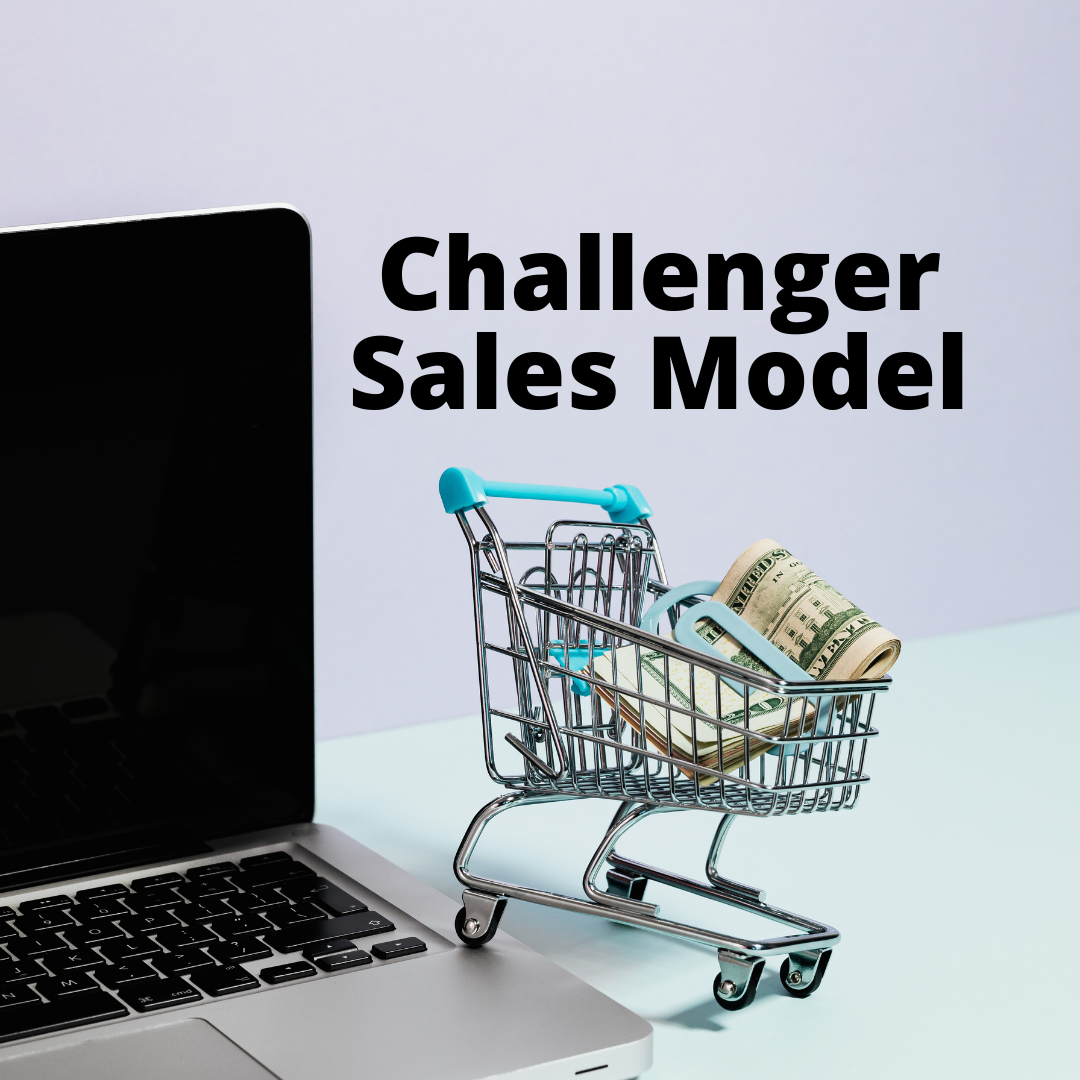One of the trickiest parts of any business is pricing its products and services. Pricing is that delicate matter which plays a significant determining role in the success of any business. If you set your prices too high, you will miss out on valuable sales. If you set your prices too low, you will miss out on valuable revenue.

While this sounds like sinking ground no matter what, that is far from the truth. This is because there are many pricing models and strategies aimed at helping you set the correct prices for your audience and meet your revenue targets.
Go through this article, and you will find your perfect sales pricing guide.
What is a Sales Pricing Strategy?
A sales pricing strategy is a model or a method used to establish the best price for your product or service. It helps you choose prices that will maximize your profits and shareholder value while considering consumer and market demand.
A lot will go into your sales pricing strategy, starting from your revenue goals, marketing objectives, target audience, brand positioning statement, product attributes, and extent of brand awareness, customer loyalty, and customer retention. In addition to this, they are also influenced by external factors like competition’s sales pricing strategy, consumer demand, and overall market and economic trends.
While we know that a sales pricing strategy is best when it maximizes your profit and revenue, the base of designing such a strategy lies in understanding the price elasticity of demand for your products and services.
Price Elasticity of Demand
The price elasticity of demand for your products or services is used to determine how a price change will affect your consumer’s demand. If your consumer continues to purchase your product or services even after a price increase, then the demand is understood to be inelastic. However, if the demand for your products and services is affected by price changes, the demand is elastic.
The formula for calculating price elasticity is:
% Change in Quantity Demanded / % Change in Price = Price Elasticity of Demand
An ideal situation is one where the price elasticity is inelastic so that the demand for your products and services remains stable even if the prices fluctuate.
Types of Sales Pricing Strategies
Sales Pricing Strategies are those that will act as the guide for you to design your own sales pricing strategies for your products or services. It is not necessary for only one sales pricing strategy to be used standalone as several can be combined and used together when setting prices for your products and services, with the goal being the maximization of your profit and revenue.
This section of the article will take you through different types of sales pricing strategies. They are:
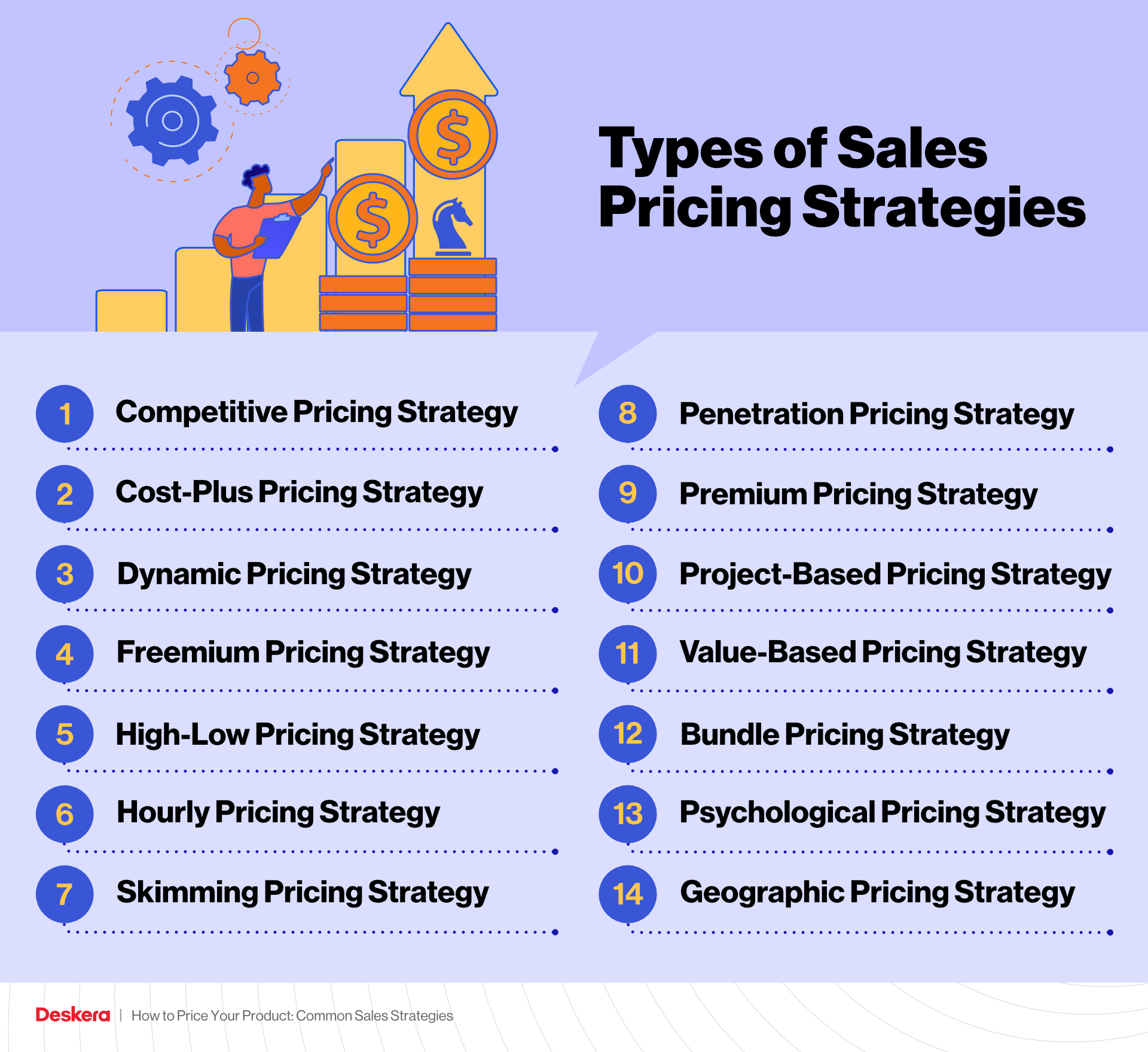
Competitive Pricing
Competitive pricing is also known as a competition-based sales pricing strategy. This sales pricing strategy focuses on the current market rate for a company’s product or service. It does not take into consideration the cost of their product or the consumer demand.
Under this sales pricing strategy, the competitor’s price is used as a benchmark for determining your own prices. A competitive sales pricing strategy is preferred by those businesses who compete in a highly saturated market where even a slight price difference will become the deciding factor for their customers.
If you are incorporating a competitive sales pricing strategy, then you can:
- Price your products slightly below your competition.
- Price your products at the same price as your competition.
- Price your products at a slightly higher price than your competition.
Whatever it is that you choose to do, remember that competitive sales pricing is one of the ways of staying on top of your competition. Under this sales pricing strategy, your pricing will especially have to be dynamic, your products or services should offer something that your competitors do not- like the best customer service, generous return, and exchange policy, or access to exclusive loyalty benefits.
Cost-Plus Pricing Strategy
A cost-plus sales pricing strategy focuses only on the COGS (i.e., cost of producing your product or service). This sales pricing strategy is also known as “markup pricing” because businesses who incorporate it would be marking up their products based on the profit they would like to earn.
To apply a cost-plus sales pricing strategy, you will need to add a fixed percentage to your product production cost. For example, if a pair of shoes cost you INR 500/- to make and you want to make an INR 50/- profit on each sale, your decided markup for each of such shoes would be 10%.
This sales pricing strategy is most often used by retailers who sell physical products as it is not a good fit for service-based or SaaS companies. Cost-plus sales pricing strategy is not a good fit for service-based or SaaS companies as they offer far greater value than the cost incurred in creating them.
Additionally, this sales pricing strategy works best only when your competitors are also using the same strategy. It will do you no good if your competitor is focusing on acquiring new customers while you are focusing on increasing your net profits. It hence becomes crucial for you to undertake a pricing analysis of all your closest competitors so that once you incorporate this strategy, it will help you meet your goals.
Dynamic Pricing Strategy
Dynamic sales pricing strategy is also known as surge pricing, demand pricing, or time-based pricing. It is a flexible sales pricing strategy where the prices fluctuate based on market and customer demand.
This sales pricing strategy is most often used by hotels, airlines, event venues, and utility companies who also apply algorithms to consider competitor pricing, demand, and other such factors before determining a final price for that particular time. These algorithms are designed to allow the companies to shift their prices to match when as well as what the customer is willing to pay at the exact moment when they are ready to make a purchase.
The merit of this sales pricing strategy lies in the fact that it helps in keeping your marketing plans like content marketing, performance marketing, email marketing, social media marketing, or marketing through landing pages on track. Your team can plan for promotions in advance and configure the pricing algorithm you use to launch the promotion price at the perfect time. You can even A/B test dynamic sales pricing in real-time to maximize your profits.
Freemium Pricing Strategy
This sales pricing strategy is a combination of 2 words- “free” and “premium.” Freemium pricing is when the companies offer a basic version of their product, hoping that their customers will be ready to pay to upgrade or access more features.
Unlike the cost-plus sales pricing strategy, freemium is that sales pricing strategy that SaaS and other software companies most often use. They choose this sales pricing strategy because the free trials and limited memberships give a peek into the software’s full functionality to their potential customers, hence winning their customer’s loyalty and trust before they make the purchase. How well this strategy is doing can be measured through metrics such as ACV and ARR.
What needs to be taken care of when using this sales pricing strategy is that the prices should represent the perceived value of your products and be only a low barrier to entry and grow incrementally as your customers are offered more features and benefits. For example, after offering a free trial version, you cannot ask your potential customers to directly pay $100 to access the paid version of the software and all its features.
While freemium might not initially give you high net incomes as a sales pricing strategy, its merit lies in the fact that it gives access to your customers with whom you can then take up one-to-one marketing efforts. With access to their email inboxes, phone numbers, or any other contact information in exchange for a free product, you would be able to nurture your lead into a customer who is loyal to your brand.
High-Low Pricing Strategy
A high-low sales pricing strategy is where the company initially sells a product at a high price but lowers it once its novelty or relevance starts to drop. The most common examples of high-low pricing strategies are discounts, clearance sections, and year-end sales. Because of these reasons, this sales pricing strategy is also known as the discount pricing strategy.
The high-low sales pricing strategy is most commonly used by the retail firms who sell seasonal items or products that often change- such as clothes, decor, and furniture. This strategy is especially appealing to the sellers as consumers plan their big buying plans as per these special days of discount. During these discount days, the seller can increase sales in what would have otherwise been a traditionally slow month.
Hourly Pricing Strategy
Hourly sales pricing strategy is also known as rate-based pricing strategy. This sales pricing strategy is most commonly used by consultants, freelancers, contractors, and other such individuals or laborers who provide business services. Hourly pricing is pretty much about trading time for money. However, because this sales pricing strategy rewards labor over efficiency, some clients are hesitant to honor this strategy.
If your business thrives on quick and high-volume projects, in that case, hourly pricing is the best incentive for customers to work with you. By breaking down your prices into hourly chunks, customers would be able to decide to work with you based on a low price point. This would be instead of them finding room in their budget for an expensive project-based commitment.
Skimming Pricing Strategy
A skimming sales pricing strategy is where the companies charge the highest possible price for a new product but lower it over time as its popularity starts waning. The difference between skimming and high-low pricing strategy is that unlike in the case of high-low pricing strategy where the prices are reduced abruptly, they are reduced gradually and overtime under skimming pricing strategy.
This sales pricing strategy is best used for technology products like DVD players, video game consoles, and smartphones as they become less relevant over time. The merit of this sales pricing strategy lies in the fact that it helps recover sunk costs and helps sell products after their novelty is worn off. However, its demerit is that it will end up annoying consumers who bought it at full price while also attracting competitors who have recognized the “fake” pricing margin as the prices are lowered.
Skimming pricing strategy hence works well if those products have varying life cycle lengths. If your product has a short life cycle, you will have a short time to skim your profits in the beginning stages of your life cycle. However, if your products have a longer life cycle, in that case, your product would be able to stay at a higher price for a longer time, hence increasing your gross profits.
Through this sales pricing strategy, you would also be able to maintain your marketing efforts for each product more effectively without constantly adjusting the pricing across every product you sell. Additionally, this strategy will also help improve the cash flow of your business while increasing the ratio of accounts receivable against accounts payables.
Penetration Pricing Strategy
Penetration pricing strategy is a complete contrast to skimming pricing strategy. As per this sales pricing strategy, you enter the market with an extremely low price, effectively drawing attention as well as revenue away from your higher-priced competitors. However, this sales pricing strategy is not sustainable in the long run as it increases the ratio of operating expenses over operating incomes. Considering this, it is applied for a short time.
The pricing method is used by those new brands who are still looking for customers or businesses entering into an already existing competitive market. This strategy is all about disruption and temporary loss with the hope that you will have returning customers even after you raise your prices.
Under this sales pricing strategy, the money would not come in overnight. Still, with enough value and a great product or service, you would continue making money, scaling your business, and increasing prices over time. The best way to ensure this is by marketing the value of your products more than their reduced prices. This will increase customer retention as well as customer loyalty.
Premium Pricing Strategy
This sales pricing strategy is also known as prestige pricing and luxury pricing. Premium sales pricing strategy is the one under which the companies price their products at a higher price to put out the image that their products are high-value, luxury or premium. It hence focuses on the perceived value of the product rather than at the actual value or at the production cost.
Premium pricing is hence a direct function of brand awareness and brand perception. Brands that use this sales pricing strategy are known for providing value and status through their products- which is why they are priced higher than their competitors.
Fashion and technology are those sectors that use this strategy the most as they can be marketed as luxurious, exclusive, and rare. Influencer marketing, controlling supply, and driving up demand are the few ways to market your product to influence a premium perception.
Project-Based Pricing Strategy
This sales pricing strategy is the opposite of the hourly sales pricing strategy as it involves charging a flat fee per project instead of the direct exchange of money for time. A project-based sales pricing strategy is also used by consultants, freelancers, contractors, and other such individuals or laborers who provide business services.
A project-based sales pricing strategy can be estimated based on the value of the project deliverable. Those who choose this sales pricing strategy can also create a flat fee for the entire estimated time of the project. Hence, to market using this sales pricing strategy, you should focus on the benefits that your customer will derive from you working on the project.
This will make it more appealing to them to pay you as per the project. The merit of this strategy is that your clients would be assured of you working with them till the entire project is completed and not only till when the allotted hours are depleted.
Value-Based Pricing Strategy
A value-based pricing strategy is a sales pricing strategy where the companies price their products or services based on their customers' willingness to pay. This stays even if they can charge more for a product or service.
Under this sales pricing strategy, priority is given to the customer’s interest and data. Hence, the merit of this is that it helps boost your customers’ sentiments and loyalty and helps you prioritize your customers in other facets of your business, like marketing.
However, the flip side of this sales pricing strategy is that it requires you to constantly be in tune with your various customer profiles as well as with their buyer personas and then vary your prices according to them. To market under this sales pricing strategy, you will have to lead with the value you are providing after making sure that your audience is distinct enough to be willing to pay so that you do not undercharge or overcharge them.
Bundle Pricing Strategy
A bundle pricing strategy is one where you offer a bundle of two or more complementary products or services together and sell them for a single price. It would then be your call to sell your bundled products only as bundled products or services or as both components of bundles and individual products.
This sales pricing strategy is hence a great way of adding to the value that you are offering to your customer who is willing to pay extra upfront for more than one product. It is also a fantastic marketing tactic as it gets your customers hooked on more than one of your products faster.
It hence helps you to sell more of your products and services than you would sell individually. Additionally, it is also a great way to upsell and cross-sell your products in a manner that is beneficial to your customers and your revenue goals.
Psychological Pricing Strategy
Psychological pricing strategy is a sales pricing strategy that targets human psychology to boost their sales. Let's take an example- according to the 9-digit effect, even if a product that costs INR 29,999/- is essentially INR 30,000/-, your customers are most likely to see it as a good deal simply because of the “9” in price.
Another way of using psychological pricing is by putting a more expensive item directly next to (either in-store or online) the one you are most focused on selling. You can also offer discounts in the manner that, “buy one, get another at 50% off (or for free).” Such deals will make your customers feel that the purchasing circumstances are too good for them to miss out on.

Lastly, changing the font, size, and color of your pricing information on and around your products has also been proven to boost sales in various instances. This hence reveals that psychological sales pricing strategy is the one that requires an intimate understanding of your target market in order to get the best results.
If your customers are the ones who are inclined towards discounts and coupons, then appealing to this desire through your marketing will help your product to meet their psychological need to save money. However, if quality is an essential thing that your customers are looking for in your product or services, then charging them the lowest will not help you meet your sales targets.
Hence, your marketing under this sales pricing strategy should meet the motivations that drive your customers. Once you have understood that motivation, you will be able to design your sales cycle and determine your sales process accordingly.
Geographic Pricing Strategy
A geographic sales pricing strategy is the one under which the products or services are priced differently depending on the geographical location or market. This strategy can be used if a customer from another state or a country is making a purchase which brings into consideration the disparities in factors like the economy or wages (from the location in which you are selling a good to the location of the person it is being sold to).
Thanks to social media marketing as well as digital marketing through mediums like landing pages and CTAs on the websites, marketing a geographically priced product or service has become easy. Segmenting by the zip code, city, or even region can be accomplished at a low cost with accurate results. Even if your specific customers travel or permanently move, your pricing model will remain the same, which will help you in maintaining your marketing costs.
Pricing Models Based on Industry/Business
As seen above, not every sales pricing strategy is for every business. Some are better suited for the physical product, whereas others are better suited for digital products. Even within these, there are several other factors to be considered before you finalize your pricing.
In this section of the article, we will be discussing some industry or business-based sales pricing models.
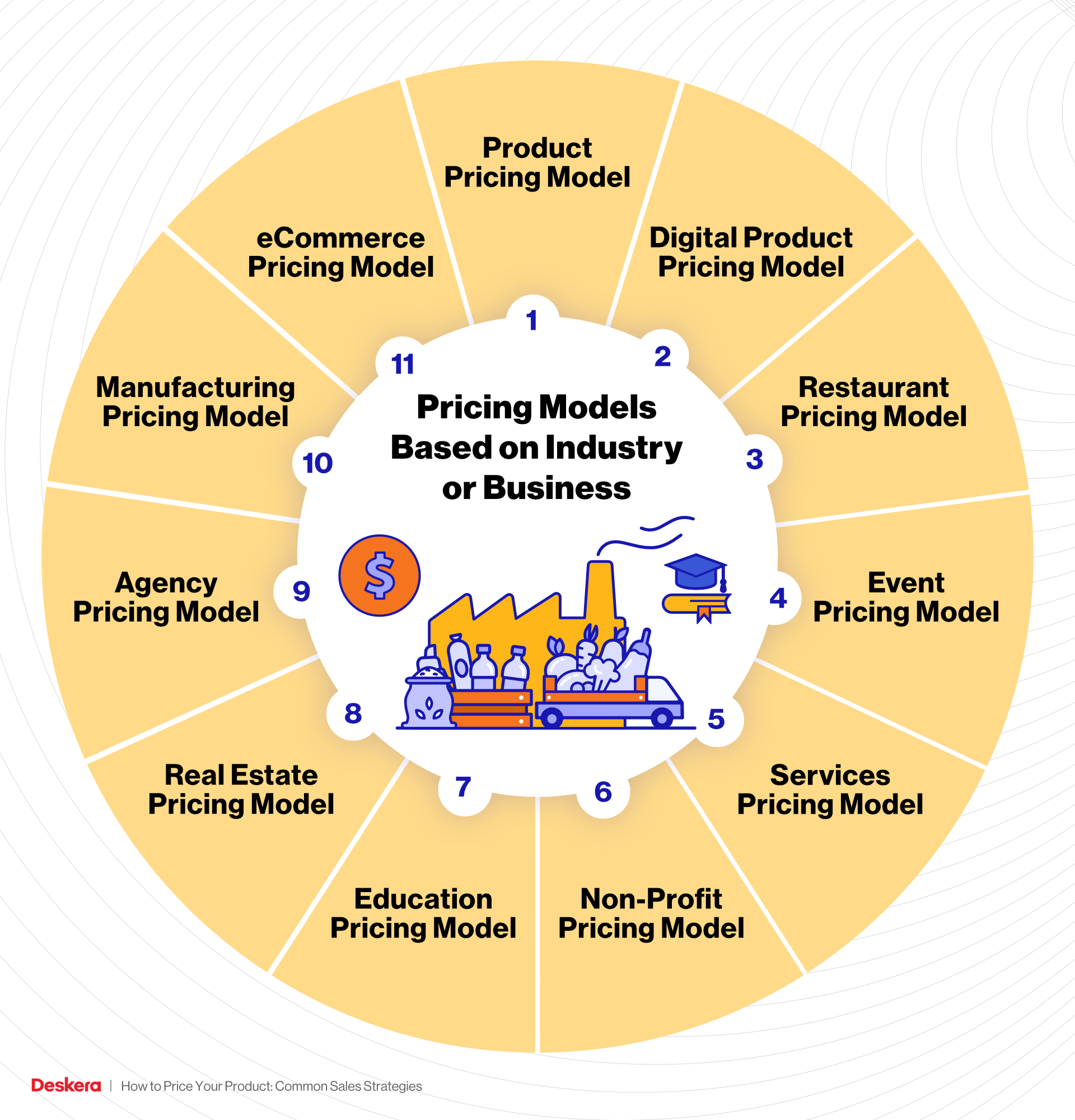
Product Pricing Model
This is for physical products, the making of which involves hard costs like shipping, production, and storage that influence pricing. A product pricing should consider these costs and then set a price that maximizes your profit, supports further research and development, and stands up against competitors. Some of the sales pricing strategies you should follow when pricing physical products are: cost-plus pricing, competitive pricing, prestige pricing, and value-based pricing.
Digital Product Pricing Model
Digital products refer to software, online courses, and digital books, to mention a few. To price such digital products, you will have to do so in a manner that reflects your brand, industry, and overall value of your product. Some of the sales pricing strategies that you can incorporate are: competition-based pricing, freemium pricing, and value-based pricing.
Restaurant Pricing Model
Restaurant pricing is one of the most special pricing as it involves physical costs, overhead costs, and service costs. You will have to consider your customer base, overall market trends for your location and cuisine, and even the cost of food- all of which are likely to remain fluctuating time and again. The sales pricing strategy that you can use for restaurant pricing are: cost-plus pricing, premium pricing, and value-based pricing.
Event Pricing Model
Events cannot be measured accurately based on production cost only. Instead, for pricing events, they will have to be determined by the cost incurred in the marketing and organizing the event - like, speakers, entertainers, networking, and the overall experience. The ticket prices should reflect all of these factors. The sales pricing strategies you should use are: competition-based pricing, dynamic pricing, and value-based pricing.
Services Pricing Model
Business services are trickier to price because of their intangibility and lack of direct production cost. Much of the value for the services they provide comes from the service provider’s ability to deliver as well as their assumed caliber of their work. This model is especially adhered to by freelancers and contractors, and some of the sales pricing strategies that they should use are: hourly pricing, project-based pricing, and value-based pricing.
Non-Profit Pricing Model
A pricing strategy is required by the non-profits, too, so that they can optimize all of their processes in a manner that they are successful over an extended period of time. As a non-profit organization, you should consider your current spending, expenses, breakeven number of your operation, ideal profit margin, and how the strategy will be communicated to volunteers, licensees, and anyone else who needs to be informed.
Non-profit sales pricing strategies tend to be unique as they consist of elements that come from various pricing strategies. Some of the sales pricing strategies that you can resort to in this case are: competitive pricing, cost-plus pricing, demand pricing, and hourly pricing.
Education Pricing Model
To price an education, you will have to consider a wide range of costs like the level of education that you will be providing, whether it is private or public education, and what is the education's program/discipline. Some of the other specific costs you will have to consider are tuition, scholarships, additional fees (labs, meals, books, housing, etc.).
The other determining factors for pricing your education would be competition among similar schools, number of student applications, number and costs of professors/teachers, and attendance rates. The sales pricing strategies that you can use in this pricing model are: competitive pricing, cost-based pricing, and premium pricing.
Real Estate Pricing Model
Real estate involves home value estimates, market competition, housing demand, and the cost of living. The other factors that play a role in real estate pricing models are potential bidding wars, housing estimates and benchmarks, and seasonal shifts in the real estate market. The sales pricing strategies that you can rely upon are: dynamic pricing, competitive pricing, premium pricing, and value-based pricing.
Agency Pricing Model
An agency pricing model will affect your profitability, retention rates, customer happiness, and how you market and sell your agency. When you are developing your agency’s pricing model, you should also consider different ways to optimize your agency to boost your business profits. The sales pricing strategies that you should consider are: hourly pricing, project-based pricing, and value-based pricing.
Manufacturing Pricing Model
To price anything that you manufacture, you would need to consider several factors: product evolution, demand, production cost, sale price, unit sales volume, and any other costs related to your process and product.
You will also need to understand the maximum amount the market will pay for your profit to allow for the greatest possible profit. The sales pricing strategies to be used here are: competitive pricing, cost-plus pricing, and value-based pricing.
eCommerce Pricing Model
This involves the determination of the price at which you will sell your online products and the cost incurred by you to do so. In pricing your eCommerce products selling pricing, you will also have to consider costs incurred for online campaigns to promote these products, as well as how easy it is for your customers to find similar products to yours on the eCommerce sites of your competitors.
In this case, the sales pricing strategies that you should use are: competitive pricing, cost-based pricing, dynamic pricing, freemium pricing, penetration pricing, and value-based pricing.
How Can Deskera Help Your Business with Sales and Sales Pricing?
Deskera is that all-in-one software that comes with its own Deskera CRM and CRM+ software. Staying true to its aim of serving all of your business needs through its software, Deskera’s CRM is an easy-to-use, accessible and powerful software that will help you with all your sales and marketing functions.
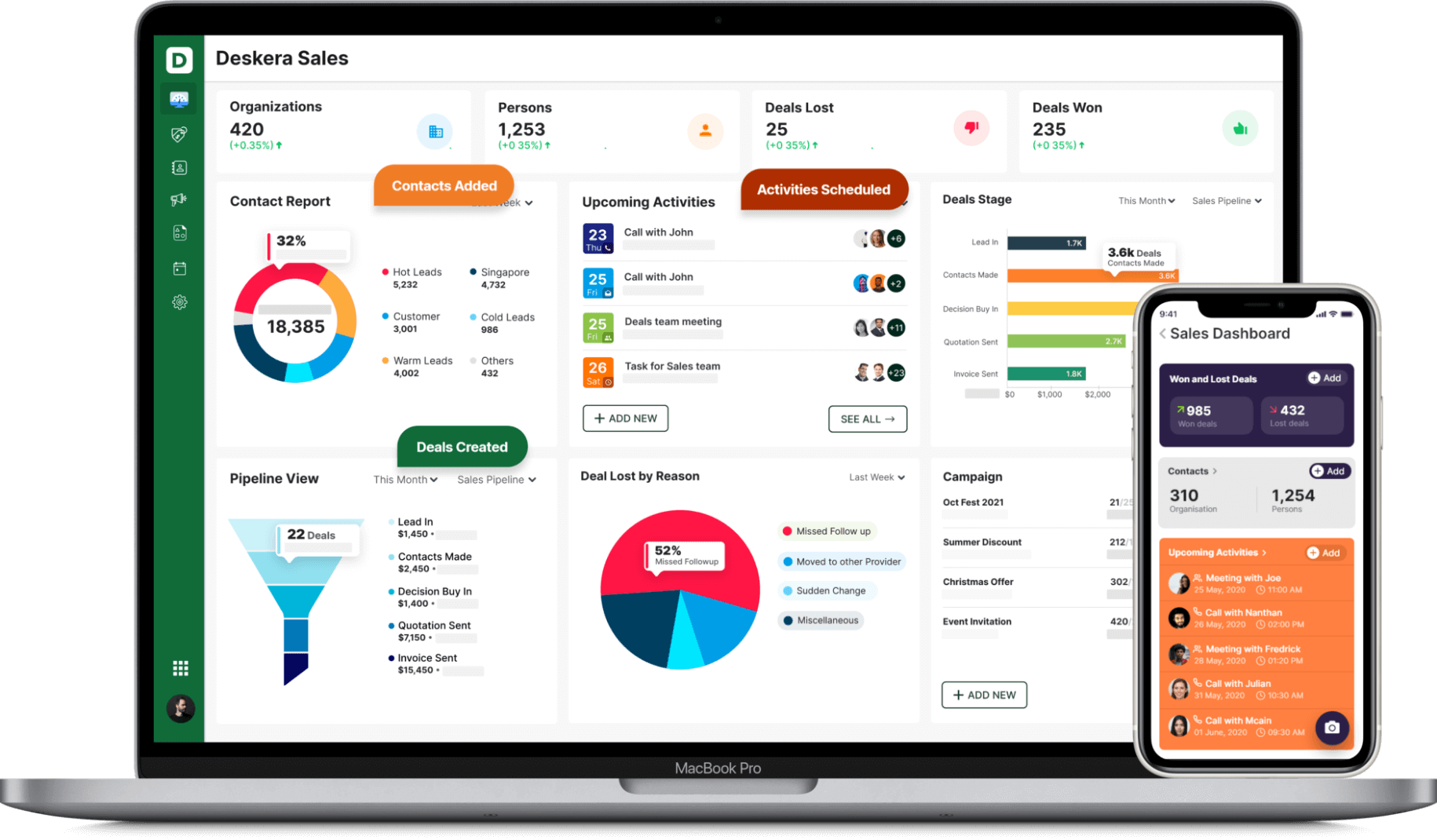
Whether it is creating your own customized sales pipeline or keeping track of all your contacts and deals, or it is about having effective lead management, Deskera CRM will handle it all for you. In addition to all this, it will also generate insights like ACV vs. ARR and marketing KPIs, to mention a few key performance indicators so that you can assess your performance as well as plan future strategies.
Additionally, it will also help you import all your contacts on one platform, comes with templates for email marketing campaigns as well as landing pages, and will facilitate the designing of the most effective CTAs for your websites.
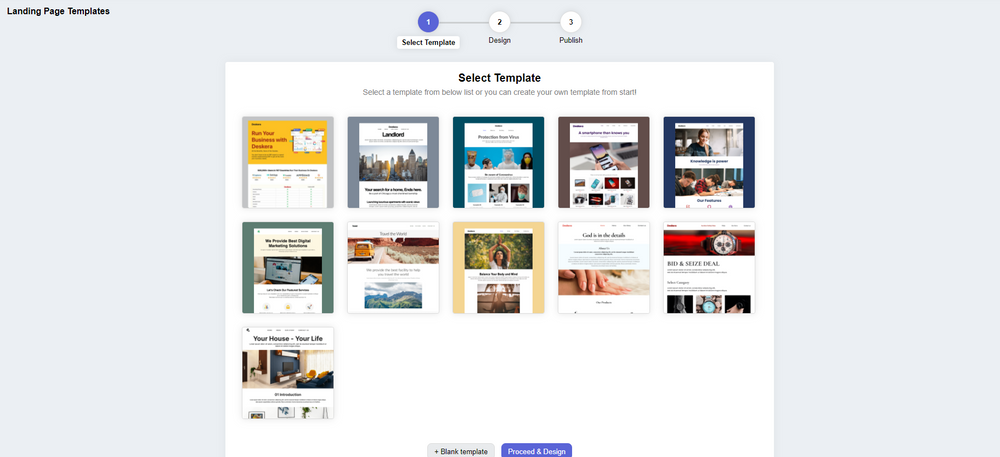
It will also ensure that your business is always on time by setting up activity reminders and letting you plan all your activities on its calendar. Based on your plan and your team’s progress, you will also be able to monitor your sales, making changes as and when needed. Lastly, Deskera CRM and CRM+ will also help you track and solve all your customer support tickets from one place with ease.
All of these features and functions will be of the utmost significance to your sales team, marketing team, customer success manager, and you- the business owner. So what are you waiting for? Try this amazing software now!
Key Takeaways
Pricing the products and services of your business is one of the trickiest tasks you will ever engage yourself into as it can determine the success of your business. This means that deciding a sales pricing strategy for your business should be done with utmost care. To do so, your first step should be undertaking a price analysis so that you can evaluate your current pricing strategy against the market demand. Pricing analysis tends to be done independently of the cost, and to do so,
- Determine the true cost of your product and service by considering fixed and variable costs
- Understand how your target markets and customer bases will respond to the pricing structure
- Analyze the prices set by your competitors
- Review any legal or ethical constraints to the final cost and price
Once you have done this, you would be able to identify opportunities for pricing changes and improvements, and then accordingly, you will have to choose your sales pricing strategy or your combination of sales pricing strategies. These are:
- Competition-based pricing strategy
- Cost-plus pricing strategy
- Dynamic pricing strategy
- Freemium pricing strategy
- High-low pricing strategy
- Hourly pricing strategy
- Skimming pricing strategy
- Penetration pricing strategy
- Premium pricing strategy
- Project-based pricing strategy
- Value-based pricing strategy
- Bundle pricing strategy
- Psychological pricing strategy
- Geographic pricing strategy
While this might sound very complex, the best way to go about it is by calculating all the vital numbers, figuring out which ones are the most important for your business, deciding your goals, and then based on it all decide on a sales pricing strategy or strategies that brings you the highest returns on investment. Always remember, it might take a few tries before you get your pricing right, but as long as you get it right at the earliest, it is alright.
Related Articles




